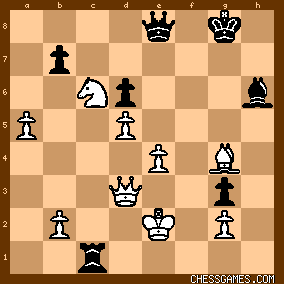| May-10-09 | | KingG: Was 21...Rxa7 22.Nxa7 Bd7, with some Knight sac on e4 or d5(or even just ...Nh7) followed by ...Qh4, working at all? |
|
| Aug-03-09 | | WhiteRook48: white then plays h2-h3 |
|
| Aug-29-09 | | KingG: Well, having now looked at 21...Rxa7 22.Nxa7 Bd7 with a computer, it seems that it fails to the move 23.Nc6!, even if it does give a very strong attack against anything else. For example 23.Nc6 bxc6 24.dxc6 Bc8 25.c7!(the promotion threat will blunt a lot of Black's attacking possibilities) Qe7 26.Nf2! gxf2 27.a6 wins for White. Meanwhile White always has the threats of Bc4 and a6. However, since taking on c6 looks horrible, so maybe Black should just move his Queen to e8, threatening to take the knight and the pawn, and then once the knight moves, simply put the queen back on d8. For example 23.Nc6 Qe8 24.Ncb4 Qd8
25.h3(White could of course chicken out with 25.Nc6)
25...Qxa5(25...Bxh3!? 26.gxh3 Qd7 27.Nf2![only move] Rg7 is interesting; all White's pieces will be tied down to the defence. However, taking on a5 prevents tricks like a6, followed by Nc6 if Black takes the pawn).
26.Qd2 Qd8 27.Rc2 Ng4!! with a strong attack.
Unfortunately, even after 23...Qe8, White just has to maintain his knight on c6 with 24.Qc2!, and I don't see any more tricks for Black. I suppose this analysis is therefore a bit pointless, but since I play this line with both colours, it has certainly been very educational for me to analyse this stuff. I'll certainly remember this Nc6 possiblity in future. Another thing I wonder is if 19...Bxd6 wasn't a better move than 19...cxd6. 19...Bxd6 20.Nb5 g3 21.hxg3 fxg3 22.Bxg3 h4 23.Bh2 Nh5 with a complicated game. |
|
| Aug-29-09 | | donehung: You cant really complain about this draw, extremely hard fought. |
|
| Dec-04-10 | | KingG: <Unfortunately, even after 23...Qe8, White just has to maintain his knight on c6 with 24.Qc2!, and I don't see any more tricks for Black.>
I should have looked more carefully, because the natural 24...Ng4! leads to an incredibly difficult position for White to defend.

click for larger viewIt would take a lot of time and space to analyse this position properly, but a sample variation would be 24.Qc2 Ng4 25.fxg4 hxg4 26.Kg1 Rh7(Bh6!?) 27.hxg3 hxg3 28.Bd1 Nf4(Bh6!?) 29.Nxf4 exf4 30.Rxf4 Bh6 31.Rxg4+ Bxg4 32.Bxg4 Be3+ 33.Kf1 Rh1+ 34.Ke2 Rxc1+ 35.Qd3 Bh6.

click for larger view
It's unlikely that White can survive this position.
Of course, these are computer variations, but it seems to me that the attacking ideas come easier than the defensive ones. Black has several attacking ideas, and by no means has to find a series of only moves, whereas White does. There are also several lines where Black could force perpetuals if he wanted. It is very possible that I have missed some chances for White, but I doubt there is a clear refutation of Black' play. Maybe White should play something else than 24.Qc2(for example 24.Ndb4), since as long as the Queen remains on d1, Black can't play ...Ng4. Nevertheless, Black can then most likely then play ...Rh7, with the idea of Ng4, and if 25.hxg3 fxg3, then ...h4-h3. |
|
| Apr-19-15 | | FM William Schill: This game is featured in Kotronias' new book on the Kings Indian and he does not think Black missed a win anywhere. |
|
|
|
|





































